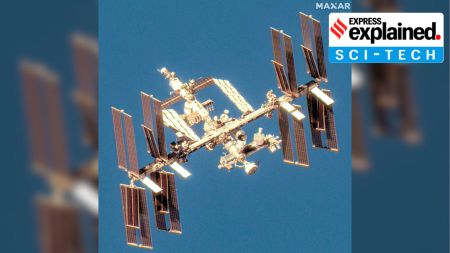
WHY THE STARLINER SPACECRAFT WITH SUNITA WILLIAMS IS YET TO RETURN, WHAT HAPPENS NOW
The return of the Starliner spacecraft, which took NASA astronauts Sunita Williams and Butch Wilmore to the International Space Station (ISS) earlier this month, has been postponed. Following lift-off on June 5, the Boeing-built spacecraft docked at the ISS and was scheduled to begin its return journey towards Earth on June 26.
Steve Stich, manager of NASA’s Commercial Crew Program, said on June 21 that they were managing the “small helium system leaks and thruster performance” on the aircraft. “We are taking our time and following our standard mission management team process,” he added.
The mission is seen as a landmark for the entry of another private player in the American space sector. Before Boeing, Elon Musk’s company SpaceX was the only one to successfully take US astronauts to space.
What is the mission, what caused the delay, and what happens to the astronauts now? We explain.
What is the Starliner Crew Flight Test spacecraft?
The Boeing website describes the CST-100 Starliner as a “space capsule that will take people to and from low-Earth orbit.” LEO refers to Earth-centered orbits with an altitude of 2,000 km or less. According to NASA, this is considered near enough to Earth for convenient transportation, communication, observation, and resupply.
Starliner’s spacecraft was developed in collaboration with NASA's Commercial Crew Program. It can accommodate up to seven passengers or a mix of crew and cargo for LEO missions. It is also reusable up to 10 times with a six-month turnaround time.
Its significance also lies in the fact that NASA stopped its Space Shuttle Program in 2011 and needed private players to step in. Back in 2012, SpaceX’s Dragon spacecraft became the first commercial spacecraft to deliver cargo to and from the ISS. In 2020, it became the first to take humans to space and bring them back.
However, Starliner’s launch has been beset by several problems. The current mission was also postponed multiple times. “A May 6 countdown was halted just two hours before launch time over a faulty pressure valve on the Atlas V upper stage, followed by weeks of further delays caused by other engineering problems…” a Reuters report said.
It was supposed to reach the ISS and dock and stay latched onto it for eight days. This would allow the astronauts to work on the ISS, where multiple countries’ astronauts carry out research and experiments. Then, it would un-dock and fly the astronauts back to Earth. The mission was mainly aimed at proving the spacecraft's ability to take the crew and bring them back.
Why is the Starliner spacecraft still in space?
There were several issues detected in some key mechanisms that need to work well for a safe flight.
According to a report from The Telegraph, the delay in launch was linked to issues detected in a spacecraft valve responsible for regulating the flow of oxidisers. On spacecraft, oxidisers are chemicals that help rockets during lift-off and in changing the rocket’s path by aiding combustion. A large amount of energy is required to propel it forward.
Before the launch, the valve was “creating an audible buzzing sound”, according to The Telegraph’s report.
Further, NASA said at one point that delaying the launch would allow teams to “further assess a small helium leak in the Boeing Starliner spacecraft’s service module traced to a flange on a single reaction control system thruster”. Helium is also essential as it pressurises the rockets, helps maintain their structural integrity, and helps manoeuvre the spacecraft.
The initial issue seemed small-scale. However, “Since its June 5 liftoff, the capsule has had five helium leaks, five maneuvering thrusters go dead and a propellant valve fail to close completely, prompting the crew in space and mission managers in Houston to spend more time than expected pursuing fixes mid-mission,” according to Reuters.
What happens now to Sunita Williams and Butch Wilmore?
The spacecraft can remain docked for up to 45 days. Beyond that, the ISS has supplies and other materials that can last for several months. Therefore, there is no immediate danger to the two astronauts.
If safety concerns remain, they may have to come back to Earth on SpaceX’s Dragon spacecraft, which is also currently attached to the ISS, according to a report in The Guardian.
Further, the spacecraft can be brought to Earth in case of an emergency, but the space agency is looking to understand the nature of the problem first in the interest of the next such mission. Crucially, as a BBC report states, a part of the service module will burn up upon re-entry, “meaning the loss of some information on what went wrong.”
For the latest news from across India, Political updates, Explainers, Sports News, Opinion, Entertainment Updates and more Top News, visit Indian Express. Subscribe to our award-winning Newsletter Download our App here Android & iOS
2024-06-28T02:27:51Z dg43tfdfdgfd